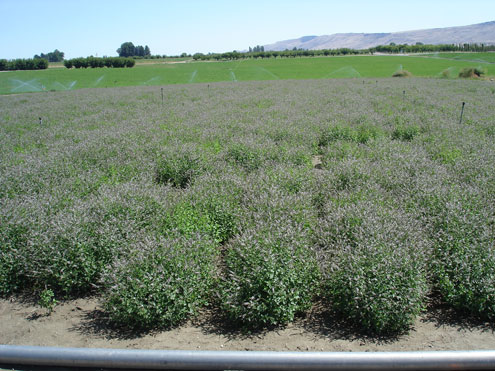Working Together for Mint
Mint oil is a major crop in the Pacific Northwest. Washington is the top-producing mint state in the nation, producing the most spearmint and peppermint. Oregon is the #2 producer of peppermint and the #4 producer of spearmint. Idaho is the #3 producer of all mint. Our project brings the USDA Agriculture Research Service together with the land-grant universities in these three states to address key issues in the region's mint industry.
Arthropods
We are studying the impacts of the aphids and spider mites, both key arthropod pests in mint. Infestations of mint aphid, Myzus menthae, stunt and distort mint stems and leaves, decreasing yield and making plants more susceptible to water stress. Mint aphid also secretes honeydew, which results in a black, sooty mold and can contribute to leaf sunburn. The twospotted spider mite,Tetranychus urticae, sucks plant juices, causing leaves to yellow, bronze, dry, and fall under heavy infestations. Spider mite infestations are known reduce oil yield and probably quality.
Weeds
Weeds are also problematic in mint. Mint is a perennial crop that is seldom cultivated after planting and has few herbicides registered for weed control. As a result, effective weed management prior to planting and in the preceding crops, especially hard-to-control perennial weeds, is important. Common perennial weeds infesting mint include Canada thistle, field bindweed, yellow nutsedge, Burmudagrass, and quackgrass. Many annual weeds infest mint as well, including several mustard species, common lambsquarters, pigweed species, kochia, Russian thistle, common groundsel, prickly lettuce, marestail, nightshade spp., barnyard grass, green foxtail, yellow foxtail, bluegrass, downy brome, and crabgrass. Western salsify, a biennial weed, is also common in mint and is increasing in importance.

Field trial in mint.
Key Pests
- Two-spotted spider mite
- Mint aphid
- Prickly lettuce
- Pigweed
- Identified by Mint Industry Research Council
- Identified in Pacific Northwest mint industry's Pest Management Strategic Plan
Journal Article
Impact of sustained deficit irrigation on spearmint (Mentha spicata L.) biomass production, oil yield, and oil quality, Irrigation Science
Fact Sheet
Project Objectives
Overall
Investigate the agronomic, biochemical, social, and economic impacts of certain biotic (e.g., spider mite, aphid, powdery/downy mildew, weed) and abiotic (e.g., water shortage/ drought) stresses on mint grown in the Pacific Northwest.
Interaction Effects & Pest Management
Discover the interactions between various irrigation (water-restriction) regimes and the various pest (weed, disease, arthropod) populations.
Food Science
Discover the biochemical and sensory impacts of varying water and pest management regimes.
Socio-Economic Impacts
Model the consumer, economic, and social impacts of the varying agronomic regimes.
Outreach
Reach over 90% of all mint producers in the nation with tools and information designed to help them optimize the quantity, quality, marketability, and sustainability of their high-value specialty crop.